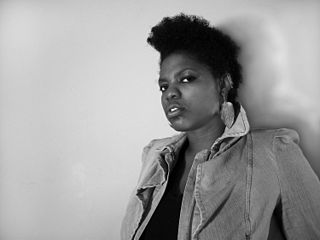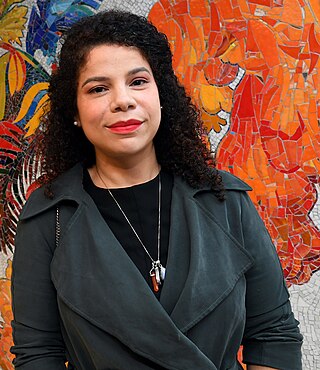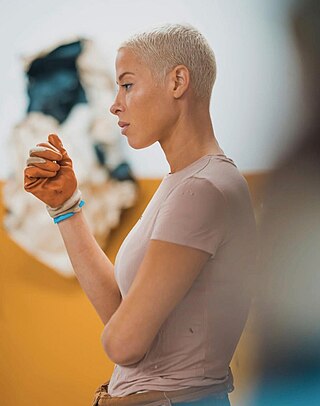Related Research Articles

Morris Louis Bernstein, known professionally as Morris Louis, was an American painter. During the 1950s he became one of the earliest exponents of Color Field painting. While living in Washington, D.C., Louis, along with Kenneth Noland and other Washington painters, formed an art movement that is known today as the Washington Color School.

Beatriz Milhazes is a Brazilian artist. She is known for her work juxtaposing Brazilian cultural imagery and references to western Modernist painting. Milhazes is a Brazilian-born collage artist and painter known for her large-scale works and vibrant colors. She has been called "Brazil's most successful contemporary painter."

Pérez Art Museum Miami (PAMM)—officially known as the Jorge M. Pérez Art Museum of Miami-Dade County—is a contemporary art museum that relocated in 2013 to the Maurice A. Ferré Park in Downtown Miami, Florida. Founded in 1984 as the Center for the Fine Arts, it became known as the Miami Art Museum from 1996 until it was renamed in 2013 upon the opening of its new building designed by Herzog & de Meuron at 1103 Biscayne Boulevard. PAMM, along with the $275 million Phillip and Patricia Frost Museum of Science and a city park which are being built in the area with completion in 2017, is part of the 20-acre Maurice A. Ferré Park.
Zilia Sánchez Dominguez is a Puerto Rico-based Cuban artist from Havana. She started her career as a set designer and an abstract painter for theatre groups in Cuba before the Cuban revolution of 1953-59. Sanchez blurs the lines between sculpture and painting by creating canvases layered with three dimensional protrusions and shapes. Her works are minimal in color, and have erotic overtones.

Ebony Grace Patterson is a Jamaican-born visual artist and educator. She is known for her large and colorful tapestries created out of various materials such as, glitter, sequins, fabric, toys, beads, faux flowers, jewelry, and other embellishments. Her "Gangstas for Life series" of dancehall portraits, and her garden-inspired installations.
Edward "Ed" Clark was an abstract expressionist painter known for his broad, powerful brushstrokes, radiant colors and large-scale canvases. An African-American, his major contributions to modernist painting remained unrecognized until relatively late in his seven-decade career, during which he pioneered the use of shaped canvases and a commercially available push broom to create striking works of art.

Cecilia Vicuña is a Chilean poet and artist based in New York and Santiago, Chile.

Xaviera Simmons is an American contemporary artist. She works in photography, performance, painting, video, sound art, sculpture, and installation. Between 2019 and 2020, Simmons was a visiting professor and lecturer at Harvard University. Simmons was a Harvard University Solomon Fellow from 2019 to 2020. Simmons has stated in her lectures and writings that she is a descendant of Black American enslaved persons, European colonizers and Indigenous persons through the institution of chattel slavery on both sides of her family's lineage.
Nicole Cherubini is an American visual artist and sculptor working primarily in ceramics. She lives and works in New York.

Firelei Báez is a Dominican Republic-born, New York City-based artist known for intricate works on paper and canvas, as well as large scale sculpture. Her art focuses on untold stories and unheard voices, using portraiture, landscape, and design to explore the Western canon.
Carlos Alfonzo (1950–1991) was a Cuban-American painter known for his neo-impressionistic style. His work has been collected by Whitney Museum of American Art and Smithsonian Institution.
Jordan Casteel is an American figurative painter. She typically paints portraits of friends and family members as well as neighbors and strangers in Harlem and New York. Casteel lives and works in New York City.
Virginia Jaramillo is an American artist of Mexican heritage. Born in 1939 in El Paso, Texas, she studied in Los Angeles before moving to New York City. She has exhibited in exhibitions internationally since 1959.
Christina Quarles is a queer, mixed contemporary American artist and writer, living and working in Los Angeles, whose gestural, abstract paintings confront themes of racial and sexual identities, gender, and queerness. She is considered at the forefront of a generation of millennial artists and her works shatter the societal manners of physical classification.
Lydia Okumura is a Brazilian artist known for her geometric abstractions.
Deborah Roberts is an American contemporary artist. Roberts is a mixed media collage artist whose figurative works depict the complexity of Black subjecthood and explores themes of race, identity, and gender politics taking on the subject of otherness as understood against the backdrop of existing societal norms of race and beauty. Roberts was named 2023 Texas Medal of Arts Award Honoree for the Visual Arts. She lives in Austin, Texas.

Kennedy Yanko is an American sculptor, painter and installation artist known for working with "paint skins" and found metal. Yanko sources discarded objects and other material from salvage yards and manipulates or modifies their form, shape, or structure into her vision. Her abstract work draws upon surrealism, abstract expressionism and physical austerities and her background in performance art.
Deborah Anzinger is a Jamaican artist who creates painting, sculpture, video and sound to "interrogate and reconfigure aesthetic syntax that relate us to land and gendered and raced bodies". Anzinger works as an artist has been featured in several exhibitions, galleries and museums which include the National Gallery of Jamaica, Pérez Art Museum Miami and the Institute of Contemporary Art, Philadelphia.
Esteban Ramón Pérez is an American artist who produces multi-media paintings and sculptures. His sociopolitical artwork often emphasizes subjective memory, spirituality, and fragmented history. Pérez earned a BFA from the California Institute of the Arts in 2017 and an MFA in painting and printmaking from the Yale School of Art, New Haven, Connecticut, in 2019. Pérez's work has been exhibited in numerous group exhibitions, including shows at Artspace, New Haven, Connecticut; Eastern Connecticut State University Art Gallery, Windham, Connecticut; Transmitter Gallery, Brooklyn; James Cohan Gallery, New York; Gamma Galería, Guadalajara, Mexico; Calderón, New York; the Arlington Arts Center, Virginia; Charles Moffett, New York; and Lehmann Maupin, New York. Solo exhibitions include Staniar Gallery, Lexington, Virginia. Pérez was selected for the NXTHVN Fellowship Program and is a 2022 recipient of the Artadia Award. He lives and works in Los Angeles, California.
Karon Davis, is an American visual artist, and a founder of the Underground Museum in Los Angeles. She is known as a sculptor and an installation artist touching on issues of race and identity in America through representations of the human body. Her artistic practice is influenced by dance, theater, and moving image.
References
- ↑ Haynes, Suyin (2023-11-13). "The painter submerging viewers into hyperrealistic water worlds". CNN. Retrieved 2024-01-05.
- ↑ "Calida Rawles discusses her hyper-realistic rippling paintings of bodies in water". www.itsnicethat.com. Retrieved 2024-01-05.
- ↑ "Calida Rawles discusses her hyper-realistic rippling paintings of bodies in water". www.itsnicethat.com. Retrieved 2024-01-10.
- 1 2 3 4 "Something Bigger Than You: In Conversation with Calida Rawles". Burnaway. 2023-04-26. Retrieved 2024-01-09.
- 1 2 Brara, Noor (2020-11-25). "'We're Coming Out From Under': Rising-Star Artist Calida Rawles on How Her Transfixing Water Paintings Address a Year of Mourning". Artnet News. Retrieved 2024-01-09.
- 1 2 3 Gomez-Misserian, Gabriela (2023-08-14). "An Artist Finds Peace Underwater". Garden & Gun. Retrieved 2024-01-05.
- ↑ Christ, Emma (2022-11-09). "Fire and Water". Artillery Magazine. Retrieved 2024-01-05.
- 1 2 Solomon, Tessa (2021-02-19). "Calida Rawles's Ethereal Paintings of Water Push the Boundaries of Portraiture". ARTnews.com. Retrieved 2024-01-10.
- 1 2 "On the Other Side of Everything • Pérez Art Museum Miami". Pérez Art Museum Miami. Retrieved 2024-01-05.
- 1 2 "Calida Rawles". The Delaware Contemporary. Retrieved 2024-01-12.
- ↑ "Calida Rawles and Deborah Roberts Have Major New York Solo Shows This Fall. Here's How They Arrived at Their Moment". www.culturedmag.com. Retrieved 2024-01-09.
- ↑ "Calida Rawles: On the Other Side of Everything". Whitewall. Retrieved 2024-01-10.
- ↑ "Calida Rawles's mural makes waves at Inglewood's new SoFi Stadium". The Art Newspaper - International art news and events. 2022-02-19. Retrieved 2024-01-05.
- ↑ "Art program at Hollywood Park celebrates diversity and culture in the community". ABC7 Los Angeles. 2022-04-06. Retrieved 2024-01-10.
- ↑ "Calida Garcia Rawles". 12th Berlin Biennale for Contemporary Art. Retrieved 2024-01-05.
- ↑ "Visiting Artist Lecture: Calida Rawles". Anderson Ranch Arts Center. Retrieved 2024-01-05.
- ↑ Ebert, Grace (2023-11-03). "In Calida Rawles' New Paintings, the Next Generation Transcends Darkness". Colossal. Retrieved 2024-01-10.
- ↑ Haynes, Suyin (2023-11-13). "The painter submerging viewers into hyperrealistic water worlds". CNN. Retrieved 2024-01-10.
- ↑ "Calida Rawles's Final White Dress Offers the Grace and Buoyancy We So Desperately Need". www.culturedmag.com. Retrieved 2024-01-10.
- ↑ "Pérez Art Museum Miami Announces Calida Rawles Exhibition, Opening June 2024 • Pérez Art Museum Miami". Pérez Art Museum Miami. Retrieved 2024-01-16.
- ↑ Valentine, Victoria L. (2023-11-06). "Forthcoming: Pérez Art Museum Miami is Presenting First Solo Museum Exhibition of Calida Rawles, Her Poetic Water Portraits Blend Hyperrealism and Abstraction". Culture Type. Retrieved 2024-04-08.
- ↑ "Calida Rawles: Away with the Tides • Pérez Art Museum Miami". Pérez Art Museum Miami. Retrieved 2024-09-17.
- ↑ Article, Jennifer Piejko ShareShare This (2024-07-19). "The Salvation of Calida Rawles's Acquatic Portraits". Artnet News. Retrieved 2024-09-17.
- ↑ "Perez Art Museum: Calida Rawles Takes A Deep Dive Into Overtown In PAMM's 'Away with the Tides'". ArtburstMiami. 2024-08-22. Retrieved 2024-09-17.
- ↑ "Calida Rawles | LACMA Collections". collections.lacma.org. Retrieved 2024-01-05.
- ↑ Gravley, Carly May. "New Exhibition at Dallas Museum Questions 'the Myth of the Sole Male Genius'". Dallas Observer. Retrieved 2024-01-05.
- ↑ "Rawles, Calida". SFMOMA. Retrieved 2024-01-05.
- ↑ "Recent Acquisitions". Spelman Museum. Retrieved 2024-01-23.